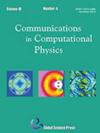从稀疏实验数据学习多尺度超弹性本构律的不变表示
IF 3.1
3区 物理与天体物理
Q1 PHYSICS, MATHEMATICAL
引用次数: 0
摘要
. 非均质超弹性材料由于其复杂多变的微观结构,其本构建模仍然是一个挑战。我们提出了一种多尺度数据驱动方法和分层学习策略,用于发现非均质超弹性材料的通用物理约束各向异性本构模型。基于稀疏多尺度实验数据,采用粒子群优化算法建立了含复合界面的超弹性组分相的本构人工神经网络。引入微观有限元耦合本构人工神经网络求解器,求解具有不同微观结构的非均质材料的均质应力-拉伸关系。利用有限元结果训练神经网络,生成密集的应力-拉伸关系数据集。在此基础上,提出了应变能函数(SEF)的通用不变表示,并利用人工神经网络(SANN)隐式表示参数集来描述具有不同微观结构的非均质材料的超弹性特性。为了保证多尺度本构模型的物理相关性,在SEF上施加了一个凸性约束本文章由计算机程序翻译,如有差异,请以英文原文为准。
Learning Invariant Representation of Multiscale Hyperelastic Constitutive Law from Sparse Experimental Data
. Constitutive modeling of heterogeneous hyperelastic materials is still a challenge due to their complex and variable microstructures. We propose a multiscale data-driven approach with a hierarchical learning strategy for the discovery of a generic physics-constrained anisotropic constitutive model for the heterogeneous hyperelastic materials. Based on the sparse multiscale experimental data, the constitutive artificial neural networks for hyperelastic component phases containing composite interfaces are established by the particle swarm optimization algorithm. A microscopic finite element coupled constitutive artificial neural networks solver is introduced to obtain the homogenized stress-stretch relation of heterogeneous materials with different microstructures. And a dense stress-stretch relation dataset is generated by training a neural network through the FE results. Further, a generic invariant representation of strain energy function (SEF) is proposed with a parameter set being implicitly expressed by artificial neural networks (SANN), which describes the hyperelastic properties of heterogeneous materials with different microstructures. A convexity constraint is imposed on the SEF to ensure that the multiscale constitutive model is physically relevant
求助全文
通过发布文献求助,成功后即可免费获取论文全文。
去求助
来源期刊

Communications in Computational Physics
物理-物理:数学物理
CiteScore
4.70
自引率
5.40%
发文量
84
审稿时长
9 months
期刊介绍:
Communications in Computational Physics (CiCP) publishes original research and survey papers of high scientific value in computational modeling of physical problems. Results in multi-physics and multi-scale innovative computational methods and modeling in all physical sciences will be featured.
 求助内容:
求助内容: 应助结果提醒方式:
应助结果提醒方式:


